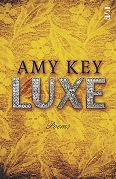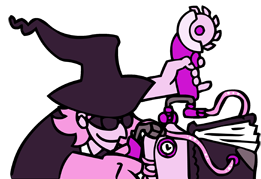
Luxe
Amy Key
Salt, £12.99

Letters to the Sky
Camellia Stafford
Salt, £12.99
reviewed by Judi Sutherland
Celebrating the English Gurlesque
Amy Key and Camellia Stafford held a joint launch party for their new collections; some of the last poetry collections to be issued by Salt and edited by Salt’s poetry editor, Roddy Lumsden (a collection by Fran Lock is still to come). The launch was held in a wine bar that is also a vintage clothes shop; pretty much the ideal venue for Key and Stafford’s collective interests.
The poems capture something brittle, flashy, a beautiful feu d’artifice, a Belle Époque theatrical performance.
These two writers are friends who share poetic influences; in particular, American poets like Chelsey Minnis and Brenda Shaughnessy. Both of them address femininity, fashion and popular culture in their work. Both are firmly located in an urban environment. Both speak about beauty and the value we place on it.
It was back in 2003 that Arielle Greenburg coined the term ‘Gurlesque’ to describe an emerging aesthestic among younger women poets. In her original essay, she describes this largely American movement as having:
a tone that was tender and emotionally vulnerable but also tough, with a frank attitude towards sexuality and a deep, lush interest in the corporeal, and that this came through in poems that were "dolled up" in a specifically girly kitsch: this work seems to share an interest in the "femme" side of feminism.
These two poets seem to be writng in this genre.
In ‘Brand New Lover’, Key presents some iconic images of femininity and sensualises them:
I’m all texture. Silk rosette, billowing coral, Tentative as a just-baked cake. Sensations Slide over my knitted blood.
The language employed throughout Luxe is sensual; the imagery is piled layer up on layer and mixes its metaphors; ‘sugar-dusted jelly, icing the glitz / of a tipped out button box’ (‘Mother of Pearl). Letters to the Sky gives a similar treatment to make-up; in ‘Before a mirror I kneel to tend my face’, the cosmetics take on a richness reminiscent of Porphyro’s feast in Keats’ Eve of St Agnes:
Possibilities of colour volunteer my eyes. Lidded chamber of rose and aquamarine shades tempt me with matte and shimmer.
Key gives us a well-imagined list poem, ‘To a Clothes Rail’, which explores the way we hide behind clothes and the personae we choose to inhabit. Stafford’s equivalent is ‘She thinks of her dresses’, citing the remembered occasions when she wore them, ending with an unworn dress that is ‘stiller than the others, without a story’.
Stafford’s collection is full of flowers. She begins ‘Liberty with Gerry’ with a mention of ‘hydrangea mop-heads’ and peonies, but it soon becomes apparent that this is no garden; we are in ‘the frisky cotillion of Great Marlborough Street’ – Liberty’s of London. Stafford’s milieu is metropolitan. Haringey and Bow both get a mention, and there is a tour de force long poem ‘Dear Camden’ at the back of the book, that explains and contextualises much of what has gone before. Key is also London-based; Camberwell Road, Walworth Road and the Shepherd’s Bush Empire are all referenced here. Where Key goes to Paris and New York, Stafford takes us to Sydney, and in ‘Away’, she goes ‘home-home’ to Warwickshire, a suburban setting where she feels she has ‘fallen out of the world’.
In both books, there’s a feeling that clothes and make-up are used to create new versions of ourselves. Stafford deals with this head on in ‘Diorama’. Key, in ‘The Trap Laid for the Glittering Life’ addresses her poem to someone ‘more costume than wardrobe’ and asks that they ‘Tell me I’m buttoned up the right way’. The vintage fashion aesthetic is all-pervasive. The poet can feel ‘low as an underskirt mood’, and in ‘Brand New Lover’, where others might want to be undressed, she implores; ‘Dress me’. Key employs this language of clothes, their style and texture, to talk about love and lovers. Stafford, in an offhand comment in ‘Dear Camden’, says; ‘My lust / for the market was perhaps averse to love.’
Greenberg acknowledged that the Gurlesque was not to be taken at face value. She reminds us that it ‘prankishly celebrates the same cultural trappings it seeks to critique’. I may be missing something, but I don’t find too much of this ironic tone in either of these collections. It seems that both poets accept, and rejoice in, this construct of femininity that is preoccupied with appearance and with coveting, and becoming, a beautiful object. Key’s work has a few dark hints later in her book that she has bought into a dangerous aesthetic. In ‘Transmitting the Fatigue of the Painter’, there’s what seems to be a Victorian girl with ‘broderie anglaised knees’, whose beautiful clothes restrict her. She is warned not to venture too far; ‘your petticoated ego / sustained only by petticoats you should not run into the sea’. In the title poem, Key gives us further clues about the source of her fashion-obsession:
‘keep down what the thighs eek for. Substitutes include mink-lined dreams, wafers of quince or rose. Substitutes are a drowsy let-down, lacking texture, like an over-pouffed dessert.’
Key and Stafford present us with two uniquely feminine poetic voices. Their work is beautiful and stunningly original, with such assured and consistent use of language to describe fabric, flowers, scent, bruiseable egos and hipster lives. The poems capture something brittle, flashy, a beautiful feu d’artifice, a Belle Époque theatrical performance. In some places, notably in Stafford’s work, there’s an over-liberal sprinkling of adjectives. Much of the writing is glittery surface. You can’t help thinking that there must be something more earthy, less sparkly, behind the jewels and perfume. It’s probable that these two smart, contemporary poets have a much broader range of interests than they present here. These collections are decadent confections; a little over-sweet, perhaps, with clever undertones of something unwholesome in our culture. After reading them both, I find myself looking for all the things they didn’t say.
Judi Sutherland gained a PhD in Biochemistry before embarking on a career in pharma / biotech and started writing poems in 2008. After redundancy in 2011, she obtained an MA in Creative Writing from Royal Holloway, University of London, and is now writing a novel, as well as poetry, blogs and reviews. Her poems have been published in Acumen, Interpreter’s House, Oxford Poetry and New Statesman, among others. Her writing blog can be found at www.judisutherland.com and her Huffington Post articles are right this way.








